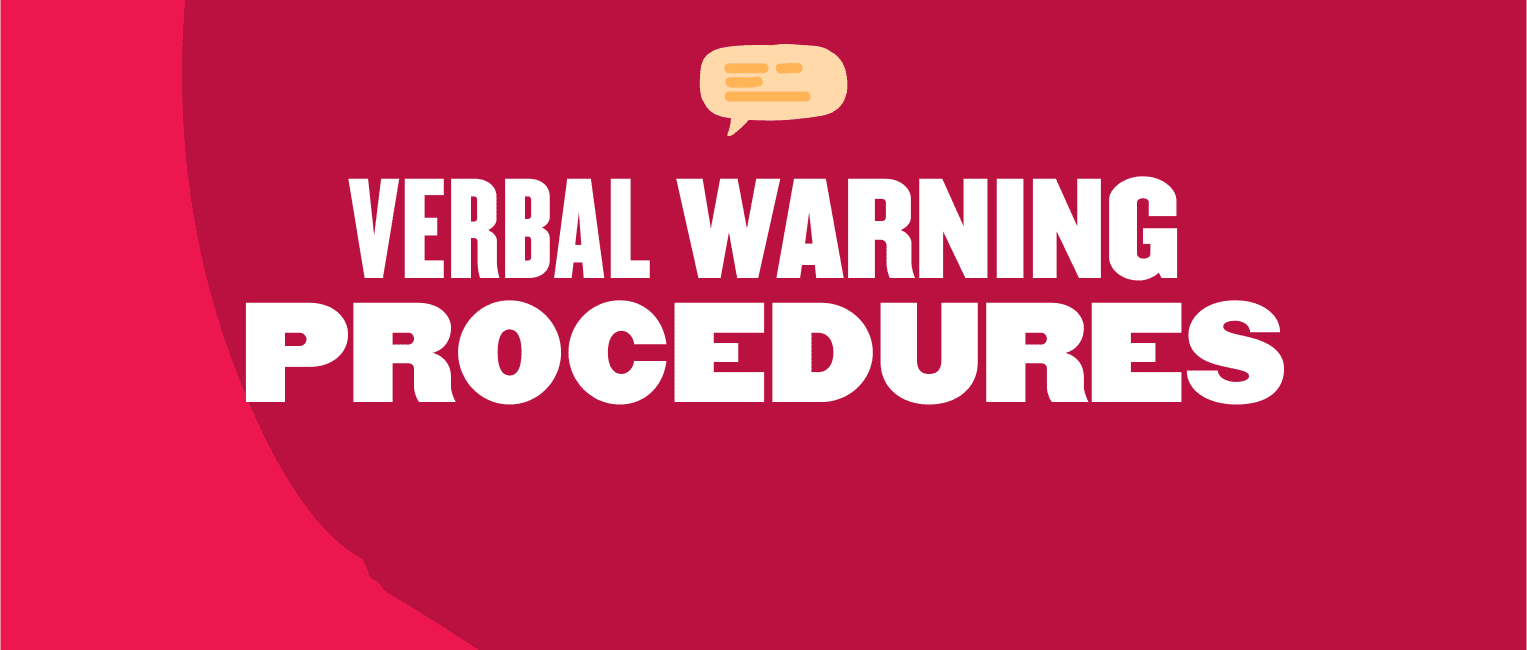Addressing performance challenges and workplace behavior proactively gives your people a chance to grow and improve. Effective people management can require having honest, constructive conversations with team members, providing additional support and resources, and resolving issues before they escalate with verbal warnings.
When approached thoughtfully, verbal warnings can encourage continuous improvement, accountability, and fairness—creating positive change across your organization. In this article, we’ll explore when to issue a verbal warning, best practices for delivering feedback, and what to include in verbal warning documentation.
<<Download this editable verbal warning documentation template.>>
What is a verbal warning?
A verbal warning is a proactive disciplinary measure that managers can use when they have concerns about a person’s performance or behavior at work. It informs team members that their actions fall short of company standards and provides them with a chance to improve.
Verbal warnings are usually the first step in a progressive discipline process, preceding measures like written warnings, formal disciplinary meetings, or suspension. They may last from three to 12 months depending on the severity of the issue and the organization’s disciplinary policies.
Verbal warnings vs. written warnings
When team members repeatedly violate policies or fail to meet expectations after receiving a verbal warning, managers may escalate to a written warning. Written warnings address more serious concerns by formally documenting the issues and setting clear expectations for improvement. You can send them by email, deliver them through HR, or present a physical copy during a private meeting.
<<Use these free written warning templates.>>
Why issue a verbal warning?
Managers issue verbal warnings to address situations where a person’s work behaviors don’t meet expectations—whether about job performance or workplace behavior. Verbal warnings help clarify expectations, encourage improvement, and maintain a productive work environment.
Job performance
Occasional performance challenges are normal, but repeated or unresolved issues can impact a team’s success. Managers may issue verbal warnings to address concerns such as:
- Failing to handle workload effectively, missing deadlines frequently, or consistently falling short of targets
- Showing little motivation to improve or allowing skill gaps to hinder performance
- Struggling to collaborate with peers or follow instructions from managers or team leads
- Repeating the same mistakes despite receiving feedback
Workplace behavior
Team member behavior impacts company culture. Poor behavior can disrupt workplace harmony, lead to higher turnover rates, and even risk undermining the organization’s core values. Managers can use verbal warnings to address:
- Missing work frequently without explanation or arriving late consistently
- Ignoring safety procedures and creating risks for others
- Violating company policies, including dress codes, time off, or attendance policy
- Bullying or harassing others in the workplace
Verbal warning procedure and best practices
A well-structured verbal warning procedure ensures people understand company expectations and how to align their actions with company values.
1. Determine whether the incident requires a verbal warning or other disciplinary action
Before taking disciplinary action, review your company’s disciplinary policy and the team member’s contract. Confirm that the person’s actions conflict with the company’s policies or their agreed terms.
If you decide the situation needs a verbal warning, the next step is determining if it needs a formal or informal verbal warning. Informal warnings often address minor concerns, such as isolated incidents or misunderstandings, where a simple conversation may resolve the issue. Managers use these warnings to provide immediate feedback and guidance without creating a formal record.
For repeated violations or more serious issues, formal verbal or written warnings are more appropriate. These warnings involve a structured conversation and clear documentation, ensuring the team member understands the gravity of the concern and the expectations moving forward.
2. Investigate and create a record
HR and managers gather relevant facts before issuing a verbal warning to ensure fairness and accuracy. This involves reviewing the situation, company policies, and any previous feedback provided to the team member.
Managers also document a verbal warning as part of their internal process to maintain transparency and consistency. While documentation ensures clarity and helps track the progression of concerns, it doesn’t always become part of a formal record. Managers can ensure they address issues constructively without prematurely affecting the person’s employment record (and future).
3. Notify the person in private
Choose a quiet, confidential setting and ensure the conversation remains professional and respectful. During the discussion, outline the issue clearly, referencing specific examples of the behavior or performance that requires improvement.
Give the person an opportunity to share their perspective, clarify any misunderstandings, and ask questions. Maintain a constructive tone to create an environment where they feel supported while still understanding the seriousness of the situation.
4. Create a plan of action with a clear timeframe
Provide a clear path to address the issue and help the person focus on improvement. Start by identifying specific steps that target the root cause of the problem. For example, if skill gaps are contributing to poor performance, suggest completing a relevant training course by the end of the quarter. If meeting deadlines is an issue, ask the team member to submit daily progress reports.
Communicate these expectations clearly and explain how you will review progress. This equips the person with a roadmap for success while reinforcing the importance of making timely changes.
5. Support your people in their growth
When delivering a verbal warning, showing a commitment to the person’s growth helps managers build trust and create a positive environment for development. Use this opportunity to:
- Offer targeted training and resources: Provide access to relevant training programs, workshops, mentoring opportunities, or technology
- Schedule regular check-ins: Set up recurring one-on-one meetings to discuss progress, provide guidance, and address any new concerns
- Encourage open dialogue: Work to uncover underlying challenges, such as workload imbalances, team dynamics, or personal issues, which might be contributing to their struggles
- Collaborate on solutions: Involve the team member in crafting an improvement plan to empower them to take ownership of their growth
6. Follow up with a performance review
After issuing a verbal warning, managers schedule a follow-up review to evaluate progress and provide feedback. During the performance review, managers can recognize improvements, reinforce positive changes, or address ongoing concerns. This consistent follow-up supports the team member’s efforts while holding them accountable for their actions.
If progress remains insufficient, managers may escalate the issue to the next step in the disciplinary process, such as a written warning. Regular follow-ups help create a culture of continuous improvement and accountability.
<<Download free performance review templates.>>
Verbal warning template: What should verbal warning documentation include?
Although verbal warnings are not formal disciplinary records, summarizing the conversation helps managers track progress and maintain accountability. Effective documentation outlines the issue, expectations for improvement, and the potential consequences of failing to meet those expectations.
Here’s a sample template for documenting a verbal warning:
Memo: Verbal warning documentation
Date: [Insert date]
Team member name & office address: [Insert name & address]
Dear [name],
This letter summarizes our meeting held on [insert date/time/location] regarding your performance/conduct. This serves as a record of our discussion and is not a formal written warning.
During the meeting, I outlined the areas requiring improvement, which included:
- [Issue 1]: On [insert date], you [issue description here].
- [Issue 2]: On [insert date], you [issue description here].
Expectations moving forward:
We agreed that you will improve in the above areas by taking the following actions:
- [Action step 1]
- [Action step 2]
Future instances of similar behavior may lead to additional disciplinary actions. I will schedule weekly check-ins to review your progress and provide guidance as needed.
As a valued member of this team, your contributions remain important. Please feel free to discuss any challenges or concerns with me at any time.
Sincerely,
[Manager name]
Acknowledgment of receipt:
By signing below, I acknowledge receiving this notice. My signature does not indicate agreement with its contents.
Signature: _________________________
Date: _______
cc.: Human Resources
<<Download this editable verbal warning documentation template.>>
Encourage your people’s growth with effective verbal warning procedures
When handled effectively, verbal warnings do more than correct behavior or performance—they open the door to deeper understanding and better collaboration. Managers use these moments to identify underlying challenges, such as skill gaps or miscommunication, and provide tailored support that empowers their people to succeed. This approach addresses immediate concerns, builds trust, and strengthens long-term engagement.
<<Download this editable verbal warning documentation template.>>
Verbal warnings FAQs
Is a verbal warning considered a formal disciplinary action?
A verbal warning is typically an informal step in the disciplinary process and isn’t considered a formal action. However, depending on their policy, some companies may issue a “formal verbal warning,” which can be recorded and included as part of the official disciplinary process.
What should you do if you receive a verbal warning at work?
If someone receives a verbal warning at work, it’s helpful to remain calm and think of the warning as constructive feedback on their behavior or performance. They can ask for specific examples of their actions that led to the warning, the time frame the warning will last for, and how they can do better within that time frame. However, if someone thinks the warning is unfair or is the result of a misunderstanding or oversight, they can dispute the warning.
Recommended For Further Reading
Can a verbal warning affect your employment record?
Employers give verbal warnings to address immediate concerns without a formal disciplinary process. They usually don’t record verbal warnings in a team member’s file, so a verbal warning will not affect an employment record.
What happens after issuing a verbal warning?
In most cases, a manager will wait for a specific period of time after giving a verbal warning for the team member to work on their behavior and performance. If there’s no improvement at the end of the warning period, the manager will escalate the situation.


